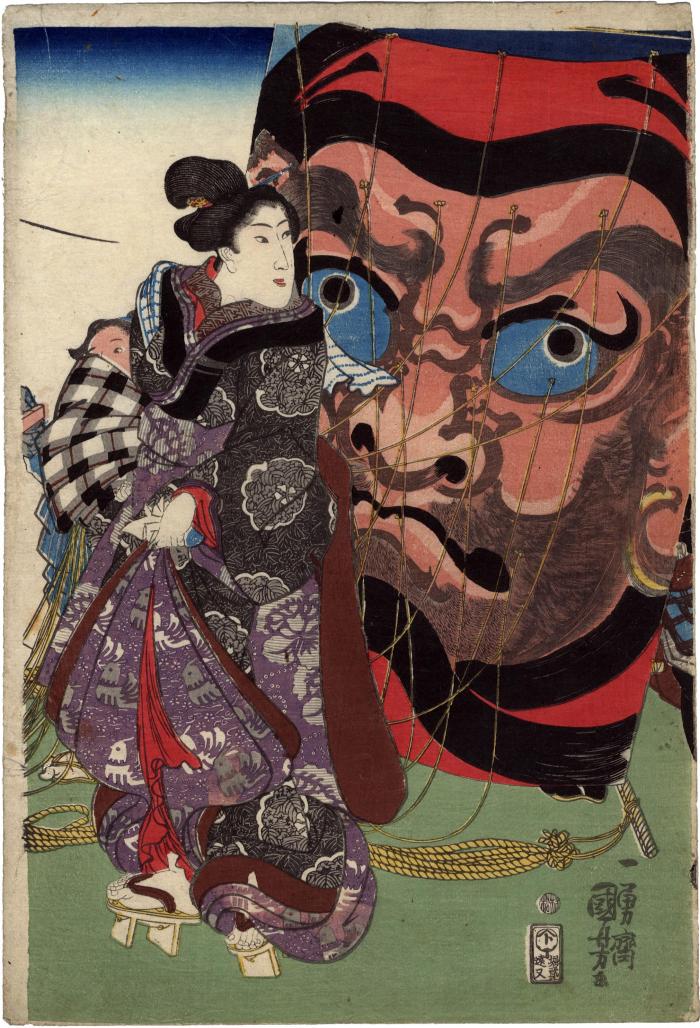Utagawa Kuniyoshi (歌川国芳) (artist 11/15/1797 – 03/05/1861)
Woman Holding a Child Before a Daruma Kite - center panel of a triptych of The Five Festivals - Mutsuki (五節句之内睦月)
ca 1847 – 1852
10 in x 14.75 in (Overall dimensions) Japanese woodblock print
Signed: Ichiyūsai Kuniyoshi ga
一勇斎国芳画
Publisher: Enshūya Matabei
(Marks 057 - seal 22-009)
Censor's seal: Muramatsu
National Diet Library - full triptych
Drexel University, Philadelphia
Adachi Museum of Art - the full triptych
Ishikawa Prefectural Museum of Art - the full triptych
Musées Royaux d'Art et d'Histoire (via Ritsumeikan University) Questions: What is the location, when is this happening and what is woman with the baby doing?
The woman with the child in this print is walking to a bathhouse. We know this because of the blue and white tenugui or hand-towel that is draped over her right shoulder and is flapping in the air behind her. She is standing in the street of the Suruga-chō (駿河町) not far from the Mitsui drapery shop, also called Echigoya. What you can't see here are the right and left panels of which this print forms the center. In the left panel another woman with a child is standing not far from the Mitsui shop, identifiable by its distinctive logo on its blue and white noren or short curtain hung at its entrance.
Mikhail Uspensky wrote on page 34 of One Hundred Views of Edo by Ando Hiroshige: "The Echigoya trade mark consisted of a circle containing two symbols: mitsu meaning "three" and i meaning "well", which between them made up the surname of the owners."
It is probably the seventh day of the New Year when the Japanese celebrate the Jinjitsu no sekku (人日の節句). It is also referred to as Nanakusa (七草) or the festival of eating seven types of herbs for good health. It is also a time for a lot of kite flying.
****
Andreas Marks added in his Japan Journeys: Famous Woodblock Prints of Cultural Sights in Japan published by Tuttle in 2015 on page 22:
"Nihonbashi, which literally means “Japan Bridge,” was the starting point of all highways that left Edo. It was therefore considered not just the heart of the city but also the heart of Japan. Said to have been originally built in 1603...."
"The Nihonbashi area was Edo's bustling center for commerce and culture. In 1683, this was where the Mitsui family established their kimono store Echigoya, which eventually became the department store Mitsukoshi. This district is today the financial center of Tokyo, home to the Bank of Japan headquarters and the Tokyo Stock Exchange."
****
Mutsuki (睦月) is the first month - now an obsolete term - of the lunar calendar. The full triptych is one of Kuniyoshi's most charming compositions. One of the tell tale signs that this is a celebration of the New Year is the hagoita being carried by the woman in the right-hand panel, not seen here.
Each panel features a bijin accompanied by a child. In this print the swaddled child is not an infant, but a child several years old apparently. Click on the print to enlarge it to see this child more closely.
****
The Five Festivals are the Gosekku no uchi (五節句の内).
****
The full triptych is illustrated in color in Kuniyoshi by Jūzō Suzuki, Heibonsha Limited, Publishers, 1992, no. 263.
Enshūya Matabei (遠州屋又兵衛) (publisher)
beautiful woman picture (bijin-ga - 美人画) (genre)
boshi-e (母子絵) (genre)
Historical - Social - Ephemera (genre)
Daruma or Bodhidharma (達磨) (role)
Nihonbashi (日本橋) (genre)
